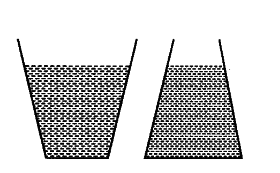Two vessels have the same base area but different shapes. The first vessel takes twice the volume of water than the second vessel requires to fill upto a particular common height. Is the force exerted by the water on the base of the vessel the same in the two cases? If so, why do the vessels filled with water to that same height give different readings on a weighing scale?
The pressure exerted by a liquid column depends upon its height. The height of water in both vessels are same, therefore the pressure on the base of each vessel will be same.

The area of the base of each vessel is also same and hence force exerted by the water on the base of the vessels is same.
Liquid also applies force on the walls of the vessel. As walls of the vessels are not perpendicular to the base, therefore force exerted on the walls by the liquid has a non-zero vertical component, which is more in first vessel. Therefore, the two vessels filled with water to the same height give different readings on a weighing scale.